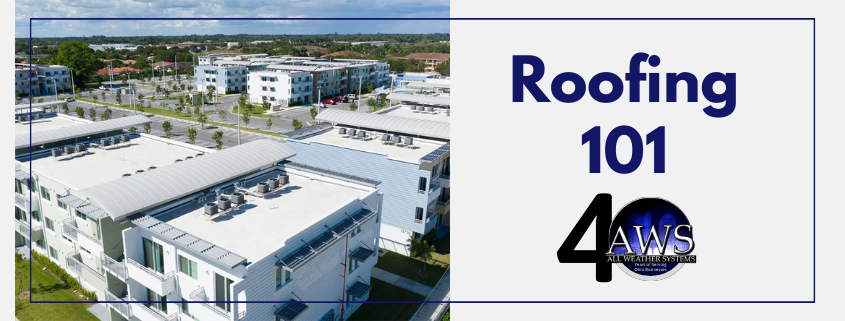Your roof is one of the biggest investments you make in your building. While you may not spend much time on top of it, your roof is always there to protect you, your employees, and your inventory. But you’re busy running your business, not becoming a roofing expert!
At All Weather Systems, we believe knowledge is power. This Roofing 101 guide will equip you with the basics of commercial roofing in Ohio, empowering you to make informed decisions for your business without spending hours sifting through information!
Understanding Roof Anatomy
Commercial roofs share some similarities with residential roofs, but the scale and materials are often different. Here’s a breakdown of the key components:
- Membrane: The top layer, often made of PVC, TPO, or EPDM and acts as the first barrier against the elements. Single-ply membranes are known for their lightweight construction, ease of installation, and exceptional durability. Duro-Last sets itself apart with its custom-fabricated system, ensuring all components perfectly fit your roof. This not only simplifies installation but also minimizes seams, reducing the risk of leaks.
- Underlayment: A layer beneath the membrane that provides additional waterproofing and protects the building deck from minor tears or leaks in the top layer.
- Flashing: Thin sheets of metal installed around roof penetrations like chimneys, pipes, and vents. Flashing prevents water from seeping into these vulnerable areas.
- Insulation: Installed on the deck, insulation helps regulate the building’s temperature, reducing energy costs.
- Roof Deck: A roof deck is the layer of material that supports the roof membrane and insulation. It can be made of different materials, such as wood, metal, concrete, or gypsum. The roof deck provides structural integrity and stability to the roof system, and also acts as a thermal barrier and a fire retardant.
Types of Commercial Roofs
The best roof for your building depends on factors like budget, climate, and desired lifespan. Here’s a quick rundown of some popular options:
- Flat Roofs: Common in commercial buildings, flat roofs require proper drainage to prevent water pooling.
- Low-Slope Roofs: Similar to flat roofs with a slight incline for better drainage.
- Metal Roofs: Available in various metals like steel or aluminum, these roofs offer exceptional longevity and fire resistance but can be more expensive. We choose Exceptional Metals for commercial metal roofing!
Roof Maintenance and Inspection
Regular roof maintenance is crucial for extending the lifespan of your roof and preventing costly repairs down the line. Here are some key maintenance tips:
- Schedule annual inspections: A qualified roofing professional can identify and address minor issues before they become major problems. Our experts at All Weather Systems have decades of experience spotting the signs of damage before they cause you a headache!
- Clear debris: Regularly remove leaves, branches, and other debris that can trap moisture and damage the roof membrane. Look for standing water, which can lead to mold and algae growth.
- Inspect for leaks: Look for signs of water damage inside the building and check for pooling water on the roof surface after heavy rain or snow.
All Weather Systems: Your Trusted Partner for Commercial Roofing in Ohio
At All Weather Systems, we are committed to providing our clients with top-quality commercial roofing solutions. Our team of experienced and certified professionals will work closely with you to understand your needs and recommend the best roofing system for your building. Contact us today for a free consultation and let us help you keep your business safe and weatherproof!
